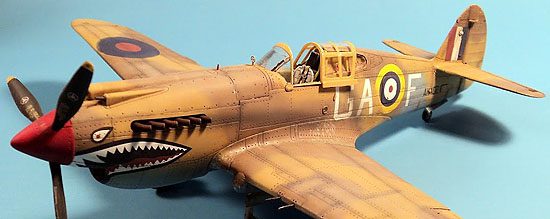While Spitfires are my all time favorite airplane, the P-40 is certainly my next favorite airplane from World War II. It was never the fastest, the most maneuverable, the highest flying, the longest ranging, or even the best looking. But it was the little engine that could. It flew in every theater, under the flag of just about every Allied nation. Despite it’s flaws, it was the third most produced US fighter of the War, with only the P-51 and P-47 exceeding it in number of aircraft built.
So the P-40 always has a special place on my build lists. And of all it’s variants, the P-40B stands out, to me, as the coolest looking Hawk of them all. With it’s long, shark-like snout, the P-40B had the look of a predator. The Spitfire was gorgeous, the P-51 elegant. The P-47 looked beastly, and the Corsair and Hellcat looked ready to brawl. But the P-40B, especially when adorned with those teeth and eyes, had the look of an airplane designed to slice in to a school of prey, leaving smoking trails of the enemy pointing earthward.
Yeah, I know it’s just a plane.. but I think it looked pretty cool.
And more importantly, it did it’s job when there wasn’t much else to fill the gap.
When it comes to the early long-nosed P-40 kits, modelers are still looking for the Holy Grail. Monogram’s kit, which has been around since the 60’s, is considered by many to be the most accurate in shape. But it’s cockpit is sparse and lacks accuracy, and it’s surface has raised panel lines and rivets. And while I am perfectly fine with raised detail, it does make sanding gaps a bit challenging. And if you choose to rescribe, that can take additional time some modelers would rather not put in.
The Academy/Hobbycraft kit has recessed detail, and it’s a more modern kit. However, it receives criticism for it’s shape, and for a rather sparse cockpit, among other things. It is a decent fitting kit, and does not present any build difficulties, which has value of it’s own.
Trumpeter’s P-40B is the most modern of the three molds available. it’s surface detailing, I think, is very nice. While many modelers will argue the accuracy of the recessed rivet detail, I think of all three it looks nicer from that perspective. And it’s shape is certainly decent. I’ve read criticisms of the shape…. from the nose to the canopy to the tail, but overall it looks like a P-40B. (Fact of the matter is, they ALL look like a P-40B…. no one could mistake them for anything else, that is for certain.)
Yet, as nice as the Trumpeter kit is, two flaws seem to jump right out. First are some raised panels on the fuselage. On the real aircraft, these were flush. On Trumpeter’s kit, though, they are represented by fairly prominent raised panels.
The second flaw is noticeable even by a Barney Builder like me, though. The cockpit. It’s undersized. It’s too small. It’s comical. It’s designed for an Oompa-Loompa, by all appearances. When I first read about this, I thought “it’s just modelers being picky and rivet-counters.” But when I received the kit, and took a look at it, I sort of chuckled. OK, it does not require a rivet counter’s hyper-critical eye for detail to call this thing undersized.
It just plain looks silly.
However, part of my goal for the build was to really get a good idea of how Trumpeter’s kit compared to the other two. I’d built the other two, and quite enjoyed them. So I wanted to see how this one fared against those.
The first thing I did was procure a replacement cockpit, opting for the Aires resin set. I won’t go into too much detail about the parts themselves, other than to say they looked much better. Their fit was not the best, however, and required quite a bit of fiddling to get into the model. (So much so that at one point I considered going with the kit supplied cockpit and just painting the whole thing orange for the Oompla-Loompa pilot.)
The fit of the kit parts, aside from the resin cockpit, was pretty good overall. I wasn’t enamored with the way the upper cowl parts went on. It’s a two-part affair with the machine guns mounted in a rear cowl portion that extends from the engine cover line back to the cockpit coaming. This part did not align perfectly with the fuselage, and left an odd gap to deal with. The forward part of the cowl was supposed to then be slid back over the machine barrels, and then glued in place. I opted to cut the gun barrels off, and slip them in later, after painting.
The rest of the fuselage fit was no problem, with only the glue bead to remove when it was joined together.
The wings are a traditional single lower wing with two uppers, and these went together well with only a few minor gaps to fill here and there with some Mr. Surfacer. (And by gaps I mean a few hairstrand thin gaps in the leading edge of the wing.) The detail in the wheel wells is nice enough, and there is some good flap area detail too, although you will have to deal with ejector pin marks.
The fit of the wing to the fuselage was good, although I did need a little filler on the underside aft join, and a quick swipe of filler at the wing roots to close a slight gap there. Because I used a water-based filler (Vallejo), I was able to fill the gap, let it set for a minute or two, and wipe off the excess with my finger, leaving almost nothing to be sanded.
I decided to do an RAF desert scheme from 112 Squadron, the original “shark mouth” squadron. I used Barracudacals excellent “P-40s of 112 Squadron RAF – Part 1”. (See sidebar for more info.) For paints, I used Xtracrylix Azure Blue on the undersides, and the top received coats of Gunze’s acrylic Dark Earth and Middlestone. (And yes, I DO miss my Pollyscale…. Testors you killed the wrong line of paint… there, I said it.) Weathering was done with various combinations of artists oils, both for dot-filtering and washes, and Tamiya Deck Tan and a mix of NATO Black and Smoke for post-shading, and of course the trusty Prismacolor silver for chipping.
These aircraft were originally received by the RAF with dark earth and dark green uppers, and the dark green was overpainted with middlestone. Photos show the port side roundel having quite a bit of overspray, so I used some artistic license to overspray the other roundels, too, just to give it a different look.
Overall, I really enjoyed this build, and was quite happy with the result. Aside from the cockpit being so plainly undersized, this is a great kit. Yes, it has some flaws… but then again, all of the P-40B kits out today do.
I suppose if I were to have to recommend a kit, Id have to ask a question- do you plan to build out of the box entirely, or are you someone who uses aftermarket? If it’s the former, I’d say I favor the Academy/Hobbycraft kit. It builds easy, it’s recessed lines make sanding easier, and it looks pretty good. If someone is more open to aftermarket, I like Trumpeter’s take on the airplane, actually. I just dig that surface detail.
Of course, we’re all hoping for the “definitive” P-40B, whatever that means. (I actually hate that term… but it’s used so often that it’s familiar.) The sad fact is, any model company who does decide to tackle a P-40 will be under so much scrutiny that even if they get it 99.9% correct, the remaining .1% will receive so much criticism from a few that it will probably sour them on ever making plastic models again. Which is kind of sad.
Regardless… if you’re looking to build a P-40B/C model, I can safely say that the Trumpeter offering is quite an enjoyable build, and when completed, it will look ready to slice through any school of enemy fighters and bombers hanging from your ceiling!

















Leave a Reply